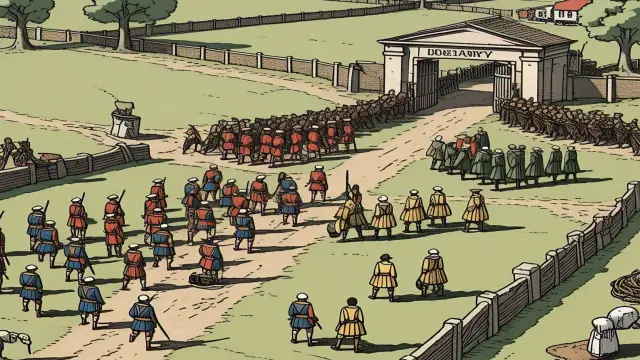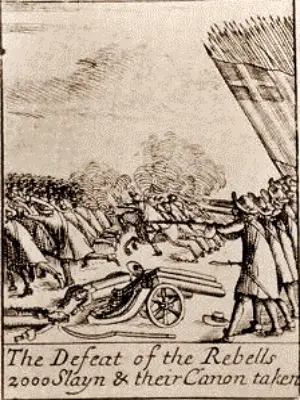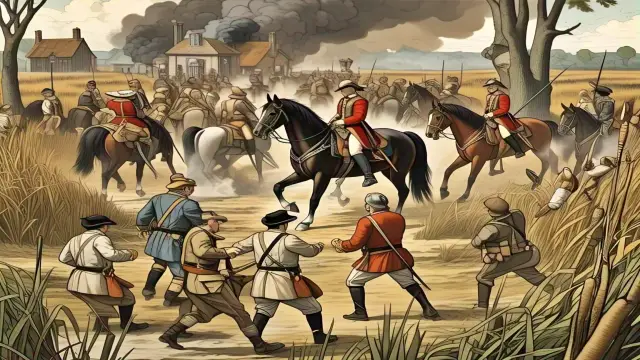The Battle of Sedgemoor
The Battle of Sedgemoor, fought on July 6, 1685, marked the end of the Monmouth Rebellion and the last pitched battle on English soil. This dramatic clash between the forces of James Scott, Duke of Monmouth, and the royal army of King James II, was a turning point in English history. Let’s explore the events leading up to the battle, the strategies employed, and the devastating aftermath.
Monmouth’s Plan: A Risky Gamble
Monmouth, an illegitimate son of Charles II, sought to overthrow his uncle, King James II, and claim the throne. After landing in Lyme Regis and gathering support, Monmouth’s forces marched through Somerset, aiming to rally more followers. His plan was bold: cross the River Severn, destroy the bridge, and use the river as a natural barrier to protect his right flank as he advanced north into Cheshire.

However, Monmouth’s strategy relied heavily on secrecy and speed. He hoped to catch the King’s forces off guard, but his plans began to unravel.
The King’s Forces: A Formidable Opponent
The royal army, led by Louis de Duras, Earl of Feversham, and John Churchill (later the Duke of Marlborough), was well-organized and disciplined. Stationed near Weston Zoyland, the King’s troops included 2,000 foot soldiers, 500 cavalry, and artillery positioned along the Bridgwater road.
Monmouth’s sympathizers, like Mr. William Sparke, kept a close watch on the King’s forces. Sparke’s servant, Richard Godfrey, acted as a spy, reporting the enemy’s numbers and positions. Despite this intelligence, Monmouth faced a daunting challenge.
The Night March: Chaos on Sedgemoor
On the evening of July 5, Monmouth’s men gathered in Bridgwater. Many were local volunteers—farmers and laborers—ill-equipped and untrained for battle. At around 11 pm, Monmouth led his troops through narrow Somerset lanes toward Weston.

The march was fraught with difficulties. Thick fog and darkness made navigation nearly impossible. Richard Godfrey, guiding the troops, missed a crucial crossing over the Langmoor Rhine, causing delays and confusion. By the time Monmouth’s forces reached Sedgemoor, they were disorganized and exhausted.
The Battle Begins: A Fatal Mistake
As Monmouth’s troops approached the King’s camp, disaster struck. A pistol shot—whether accidental or deliberate—alerted the royal forces. The element of surprise was lost.
Lord Grey led Monmouth’s cavalry forward, but their advance was halted by the Bussex Rhine, a deep ditch filled with mud and water. The King’s sentries challenged them, and royal troops opened fire, scattering the rebel horsemen.
Monmouth’s foot soldiers, positioned on the left, attempted to engage the enemy. However, their lack of training showed. Many fired high, missing their targets, while the disciplined royal troops returned fire with deadly accuracy.
The Tide Turns: Monmouth’s Defeat
As dawn broke, the battle turned decisively against Monmouth. The King’s cavalry, led by Churchill, charged into the rebel ranks, causing panic and chaos. Monmouth’s men, already disorganized, began to flee.

The royal artillery added to the devastation, cutting down fleeing rebels. Monmouth’s forces, once numbering between 4,000 and 6,000, were decimated. Around 300 rebels died in the battle, but over 1,000 were slaughtered during the pursuit. Another 1,200 were captured, many of whom faced brutal punishment.
The Aftermath: A Brutal Reckoning
The Battle of Sedgemoor ended in a crushing defeat for Monmouth. His rebellion collapsed, and he was captured days later. The King’s forces showed no mercy to the rebels. Hundreds were executed, their bodies displayed on gibbets or buried in mass graves.
The battle’s brutality left a lasting mark on Somerset. Locals were forced to dig pits for the dead, and the roads between Bridgwater and Weston were lined with the grim reminders of the rebellion’s failure.
The Last Battle on English Soil
The Battle of Sedgemoor holds a unique place in English history as the last pitched battle fought on English soil. While smaller skirmishes and sieges occurred later, none matched the scale or significance of Sedgemoor.
Monmouth’s defeat solidified King James II’s rule—for a time. However, the rebellion also sowed the seeds of discontent that would lead to the Glorious Revolution just three years later.
Conclusion: A Turning Point in History
The Battle of Sedgemoor was a tragic and pivotal moment in English history. Monmouth’s bold gamble ended in disaster, but his rebellion highlighted the deep divisions within the country. Today, Sedgemoor is remembered not only for its military significance but also for the human cost of ambition and conflict.
As we reflect on this historic battle, we are reminded of the courage and sacrifice of those who fought—and the enduring lessons of leadership, strategy, and the consequences of war.
Engage with History
If you’re ever in Somerset, visit the sites of Sedgemoor and Weston Zoyland to walk in the footsteps of history. The stories of Monmouth’s rebellion and the Battle of Sedgemoor continue to captivate and inspire.

